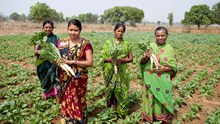
Chocolate- one of the world’s most beloved treats- owes its existence to a tropical treasure: cocoa. Grown from the delicate Theobroma cacao tree, cocoa is the lifeblood of an industry worth billions and supports the livelihoods of millions of small-scale farmers across the globe. From the dense rainforests of West Africa to the humid plantations of Southeast Asia and Latin America, cocoa plays a vital role in both local economies and global markets.
But this sweet story is facing a bitter turn. Rising global temperatures, prolonged dry spells, aging cocoa trees, invasive pests, and unsustainable farming practices are driving a steady decline in cocoa yields. In countries like Ivory Coast and Ghana together supplying over half of the world’s cocoa. Farmers are increasingly struggling to meet demand. The journey from seed to chocolate bar, once challenging but reliable, is now fraught with growing uncertainties that threaten the future of chocolate itself.
A Bitter Forecast: Climate Change Hits Cocoa Hard
Cocoa production is very sensitive to climatic change. Slight changes in rainfall and temperature have significant impacts on pod development and bean quality. In regions such as West Africa, where more than 60% of global cocoa is produced, climate change is already being felt. More frequent longer dry seasons, increased mean temperatures, and irregular rainfall are contributing to reduced yields and compromised bean quality.
Water shortages during peak growing seasons are becoming increasingly common in most cocoa-producing regions. Drought reduces flowering and causes tree stress, while excessive rain facilitates the spread of fungal diseases such as black pod rot. Cocoa farmers in regions where this crop previously flourished are now fighting to sustain life in their trees.
By the middle of this century, experts predict that vast stretches of land currently used for cocoa may no longer be suitable for the crop unless dramatic measures are taken.
Pressure Builds: Demand Grows, Yields Shrink
The global demand for chocolate keeps on expanding at a fast pace, particularly in nations such as China and India where chocolate demand is increasing. But cocoa production is not. Poor farm practices, older trees, and insufficient access to new methods are keeping productivity low. A whole year may pass before a single cocoa tree yields enough beans to make half a pound of chocolate.
Most cocoa farmers work on small landholdings less than 5 acres in many cases. They depend on the crop for their principal livelihood. They are facing falling returns, rising expenses, and unpredictable weather. Only few farmers have access to irrigation, high-quality planting materials, or climate-smart agriculture training.
Pests and Diseases
Climate change doesn’t just affect rainfall. It also fuels the spread of pests and diseases. Black pod disease, caused by a fungal pathogen, destroys pods during the rainy season. Mealybugs and mirid insects attack the tender parts of the plant, reducing yield and weakening the trees. These pests thrive in warmer, wetter climates, making them harder to control as global temperatures rise.
In most areas, farmers use chemical pesticides, which are costly and at times damaging to the environment. Lacking proper training and guidance, they cannot contain outbreaks, and crops are lost while income dwindles.
Behind the Sweetness: Deforestation and Child Labor
While cocoa serves as a livelihood for millions of families, its cultivation takes a severe toll on the environment and society. In nations such as Ivory Coast and Ghana, cocoa production has caused extensive deforestation. Farmers cut down tropical forests to plant new cocoa trees to satisfy increasing demand, rather than replanting on existing plantations. The process of clearing causes loss of biodiversity, carbon emissions, and wildlife habitat destruction.
Child labor is another dark reality. Due to the low-wage and labor-intensive nature of cocoa cultivation, children are frequently involved in planting, harvesting, and drying beans by families. Approximately 2 million children were working with hazardous cocoa-related activities in West Africa during the 2013-14 growing season. Poverty, poor regulation, and illiteracy keep the cycle perpetuated.
Seeds of Hope: Towards a More Sustainable Cocoa Future
In spite of the difficulties, there are signs of hope. Scientific breakthroughs like the sequencing of the cocoa genome have given rise to the development of new, improved cocoa varieties that are more productive and resistant to drought and disease. Certain of these newer varieties yield as much as four times the beans as the old varieties.
Major chocolate companies and global NGOs are also stepping up. Many big companies and world’s largest cocoa processors, have committed to achieving zero child labor and zero deforestation in its supply chain by 2025. Its "Forever Chocolate" initiative includes replanting cocoa on existing land and helping 500,000 farmers rise out of poverty.
Sustainable agriculture techniques, such as agroforestry (cocoa production along with trees and other crops), organic fertilizer use, and integrated pest control, are gaining attention. They not only increase production but also conserve the environment and minimize farmers' use of chemicals.
The cocoa journey is not just about the story of a chocolate story. It's a human, climate, and choice story. Millions of people globally rely on cocoa to feed their families. But pests, climate change, old trees, and unsustainable production are threatening to take the industry down.
To protect the future of chocolate, we must invest in the future of cocoa farmers. That involves providing them with access to improved seeds, sustainable methods, fair returns, and climate assistance. It involves also changing the way we grow and eat one of the world's most beloved treats. Because without strong, healthy cocoa farms, the world can wake up to a day when chocolate is no longer within our reach.















